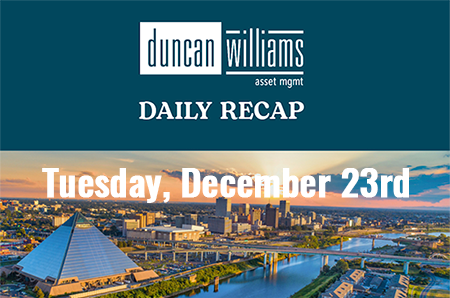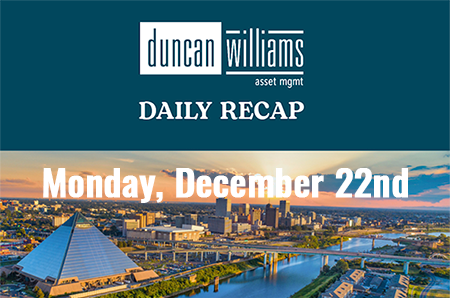
Today, the global economy and markets experienced notable shifts, with significant movements across the United States, Europe, and Asia. Recent political events, central bank policy adjustments, and evolving economic conditions drove these shifts.
The stock market continues its post-election surge in the United States, with significant indices reaching historic highs. The Dow Jones Industrial Average climbed by 1,508 points to a record 43,729.93, while the Nasdaq Composite advanced 544 points, closing at 18,983.47. Investor optimism appears buoyed by the recent election and the Federal Reserve's latest interest rate cut of 0.25 percentage points to support economic growth amid cooling inflation. This marks the second rate reduction this year, as the Fed seeks to balance stimulating economic activity and keeping inflation in check (Morningstar, YCharts).
Across the Atlantic in Europe, markets were less optimistic as investor concerns grew over the prospect of a more aggressive U.S. trade policy. European stocks and currencies saw sharp declines today, with the Stoxx Europe 600 index falling by 2%—its most significant daily drop since early August. This sell-off was driven by fears surrounding the reimplementation of aggressive U.S. trade tariffs, especially after reports that incoming U.S. President Donald Trump plans a 10% universal import tariff and a steep 60% tariff on Chinese imports. Such policies could impact the European export economy, especially with the European Central Bank (ECB) warning that Europe must be prepared for potential trade tensions with the U.S. (Financial Times, Reuters).
In Asia, mixed trends characterized the day. Japan reported nearly a 10% year-over-year export increase for December, showcasing resilience in the export-driven economy. However, stock market activity in Tokyo was more subdued, with shares dipping nearly 1% amid speculation that the Bank of Japan might pivot from its long-standing loose monetary policy, potentially signaling an end to its ultra-low interest rates. Investors are closely monitoring for changes in Japan’s economic stance, which could reshape market expectations and currency values (Wall Street Journal).
In South Korea, the Kospi index rose 0.3% to 2,601.66, reflecting cautious optimism from investors. Despite global economic uncertainties, there is confidence in South Korea’s domestic outlook, with markets appearing resilient against broader geopolitical headwinds. Analysts note that ongoing stimulus measures and stable domestic demand contribute to positive investor sentiment (The Hindu Business Line).
Conversely, China is eyeing substantial fiscal stimulus measures to counterbalance challenges in its property sector and address high local government debt. This potential stimulus package could amount to over $1.4 trillion in additional debt issuance over the coming years. Analysts believe that China’s government uses fiscal policy to navigate domestic economic struggles and position itself more competitively on the global stage amid strained U.S.-China relations (Time).
The global economy is projected to grow by a steady 3% in 2025. This optimistic outlook stems from recent interest rate cuts by major central banks and firm performance in the U.S. economy. Potential risks loom, including geopolitical tensions and high household debt in developed economies. Analysts advise that central banks may need to stay vigilant and flexible, particularly as global supply chains and trade dynamics continue to evolve (World Economic Forum).
Today’s economic landscape showcases a blend of resilience and caution across significant markets. Each region grapples with its unique set of financial challenges and growth drivers. In the coming months, markets will continue to watch the interplay of U.S. trade policy, central bank decisions, and global growth indicators for further direction.
Today, the global economy and markets experienced notable shifts, with significant movements across the United States, Europe, and Asia. Recent political events, central bank policy adjustments, and evolving economic conditions drove these shifts.
The stock market continues its post-election surge in the United States, with significant indices reaching historic highs. The Dow Jones Industrial Average climbed by 1,508 points to a record 43,729.93, while the Nasdaq Composite advanced 544 points, closing at 18,983.47. Investor optimism appears buoyed by the recent election and the Federal Reserve's latest interest rate cut of 0.25 percentage points to support economic growth amid cooling inflation. This marks the second rate reduction this year, as the Fed seeks to balance stimulating economic activity and keeping inflation in check (Morningstar, YCharts).
Across the Atlantic in Europe, markets were less optimistic as investor concerns grew over the prospect of a more aggressive U.S. trade policy. European stocks and currencies saw sharp declines today, with the Stoxx Europe 600 index falling by 2%—its most significant daily drop since early August. This sell-off was driven by fears surrounding the reimplementation of aggressive U.S. trade tariffs, especially after reports that incoming U.S. President Donald Trump plans a 10% universal import tariff and a steep 60% tariff on Chinese imports. Such policies could impact the European export economy, especially with the European Central Bank (ECB) warning that Europe must be prepared for potential trade tensions with the U.S. (Financial Times, Reuters).
In Asia, mixed trends characterized the day. Japan reported a nearly 10% year-over-year export increase for December, showcasing resilience in the export-driven economy. However, stock market activity in Tokyo was more subdued, with shares dipping nearly 1% amid speculation that the Bank of Japan might pivot from its long-standing loose monetary policy, potentially signaling an end to its ultra-low interest rates. Investors closely monitor any changes in Japan’s economic stance, which could reshape market expectations and currency values (Wall Street Journal).
In South Korea, the Kospi index rose 0.3% to 2,601.66, reflecting cautious optimism from investors. Despite global economic uncertainties, there is confidence in South Korea’s domestic outlook, with markets appearing resilient against broader geopolitical headwinds. Analysts note that ongoing stimulus measures and stable domestic demand contribute to positive investor sentiment (The Hindu Business Line).
Conversely, China is eyeing substantial fiscal stimulus measures to counterbalance challenges in its property sector and address high local government debt. This potential stimulus package could amount to over $1.4 trillion in additional debt issuance over the coming years. Analysts believe that China’s government uses fiscal policy to navigate domestic economic struggles and position itself more competitively on the global stage amid strained U.S.-China relations (Time).
The global economy is projected to grow by a steady 3% in 2025. This optimistic outlook stems from recent interest rate cuts by major central banks and firm performance in the U.S. economy. Potential risks loom, including geopolitical tensions and high household debt in developed economies. Analysts advise that central banks may need to stay vigilant and flexible, particularly as global supply chains and trade dynamics continue to evolve (World Economic Forum).
Today’s economic landscape showcases a blend of resilience and caution across significant markets. Each region grapples with its unique set of financial challenges and growth drivers. In the coming months, markets will continue to watch the interplay of U.S. trade policy, central bank decisions, and global growth indicators for further direction.
Sources: "U.S. stock markets reach record highs" morningstar.com, "Federal Reserve rate cut details" ycharts.com, "European stocks and currencies tumble" ft.com, "ECB cautions on U.S. trade policy" reuters.com, "Japan's exports and monetary policy shift speculation" wsj.com, "South Korea’s Kospi index update" thehindubusinessline.com, "China’s fiscal stimulus consideration" time.com, and "Global economic outlook" weforum.org.












